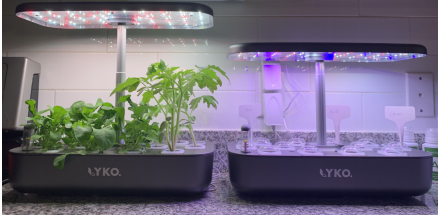Part III: Set up your light
The moment you have set up your hydroponic system and have planted the seeds, it’s now time to take a look at the different elements that will ensure fast and efficient plant growth—starting with your lighting.
The first phase in plant development is the growth of roots, followed by the plants coming to life and breaking through the soil. This is a crucial stage, one that requires the right amount of water and nutrients, air, and light.
The water and nutrients should have been taken care of when you set up the hydroponics system. And if your place is well ventilated, then you won’t have to worry about air. What you need to carefully consider is lighting. In an ideal setting, plants receive enough light from the sun. However, with your plants indoors, you need to recreate sunlight to ensure that the plants will receive all that they need to grow well.
This is why lighting has a special space in the care for hydroponic plants.

Figure 1 Photosynthesis
Step 1. Familiarize yourself with the light panel operation.
When you check the light panel in your LYKO hydroponic system, you will see a Power button that will allow you to operate the system. Turning the button on will activate the 16:8 light-dark cycle automatically—light will remain on for 16 hours and then turn off for 8 hours as the system goes into sleeping mode. The whole system will automatically follow this working cycle daily.

Figure 2
Step 2. Learn the functions of the different light mode buttons.
The image above shows a Veg button and a Flower button (middle). The key difference between them is the amount of blue light emitted in each mode. Blue light is directly related to chlorophyll production in plants, the element needed for photosynthesis to happen. It is blue light that enables seeds to sprout quickly.
In Veg mode, plants receive a great amount of blue light that enables them to develop strong and healthy stems and leaves. However, blue light limits plants from growing and extending their branches. Plants often exposed to blue light are typically shorter with smaller leaves that tend to be thicker and darker in color. Therefore, in Flower mode, the amount of blue light emitted is reduced.

Figure 3
To determine the mode you should set the system in, consider the types of seeds you planted. If they’re herbs, setting the system in Veg mode might be preferable. However, if they’re flowers or fruits, you might start with Veg mode to allow seeds to sprout, and then change to Flower mode later on once flowers or fruits become visible.
Step 3. Learn the use of the Pump button.
When you press the Power button, all the LED lights will turn on and the system will enter the Veg mode automatically. The pump button will then simultaneously turn on and the pump will automatically enter the working cycle of 30 minutes per hour. The pump regulates the oxygen level in the water, creating a better growth environment for your plants.

Figure 4
Step 4. Learn to adjust the height of the extendable rod.
You can adjust the height of the extendable rod to control the amount of light your plants receive. A minimum rod height is advised after you have planted the seeds in the pods. As your plants grow taller, you can set the rod higher to give more room to your plants.

Figure 5
Once you’ve learned all these, you’re all good! Welcome to the hydroponics world!
All you need to do is to monitor and track your plants’ growth. A notebook and pen can be handy and can be a good way to have fun while you observe the amazing growth of your plants. Happy planting!
Reference
1, https://simple.wikipedia.org/wiki/Photosynthesis
2, https://science.howstuffworks.com/life/cellular-microscopic/photosynthesis.htm
3, https://projects.ncsu.edu/project/bio183de/Lab/photosynthesis_lab/photosynthesis2.html
4, Takemiya, A., Inoue, S. I., Doi, M., Kinoshita, T., & Shimazaki, K. I. (2005). Phototropins promote plant growth in response to blue light in low light environments. The Plant Cell, 17(4), 1120-1127.
